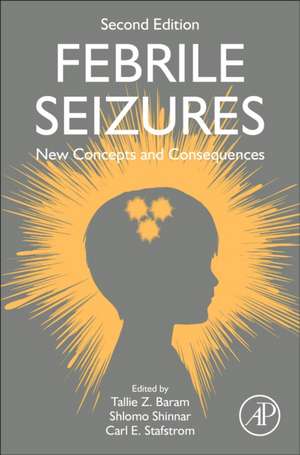Febrile Seizures: New Concepts and Consequences
Editat de Tallie Z. Baram, Shlomo Shinnar, Carl E. Stafstromen Limba Engleză Hardback – 22 sep 2022
The 20 years since the publication of this first edition have witnessed an explosion of new information about febrile seizures, meriting this new edition. Key advances have been made in the genetics and neurobiological underpinnings of febrile seizures and especially the very long fever-related seizures called febrile status epilepticus. The role of neuroinflammatory factors in the emergence of these seizures and their consequences, the demonstration of unique clinical and neuroradiological aspects of febrile status epilepticus, and the prospect of predictive (bio)markers to identify and characterize cognitive and epilepsy outcomes are exciting and important. In this edition, the authors and editors tackle these developments in chapters addressing the questions of parents, physicians, allied health care professionals and basic and translational scientists.
- Reviews all aspects of febrile seizures, including epidemiology, neurobiology and treatment
- Discusses novel and newly discovered information based on up-to the minute methods
- Provides an engaging style that is accessible to clinicians, researchers and educated parents
Preț: 704.94 lei
Preț vechi: 880.73 lei
-20% Nou
Puncte Express: 1057
Preț estimativ în valută:
134.91€ • 140.33$ • 111.37£
134.91€ • 140.33$ • 111.37£
Carte tipărită la comandă
Livrare economică 07-21 aprilie
Livrare express 08-14 martie pentru 177.19 lei
Preluare comenzi: 021 569.72.76
Specificații
ISBN-13: 9780323899321
ISBN-10: 0323899323
Pagini: 368
Dimensiuni: 152 x 229 x 25 mm
Greutate: 0.73 kg
Ediția:2
Editura: ELSEVIER SCIENCE
ISBN-10: 0323899323
Pagini: 368
Dimensiuni: 152 x 229 x 25 mm
Greutate: 0.73 kg
Ediția:2
Editura: ELSEVIER SCIENCE
Public țintă
Neurologists, epileptologists and neuroscience researchersCuprins
1. Incidence and prevalence of febrile seizures
2. Who gets recurrent febrile seizures (also complex)
3. Outcomes of febrile seizures: cognitive and epileptogenesis: B. Genetic and Acquired Syndromes Associated with Febrile Seizures
4. The genetic landscape of febrile seizures and GEFS+
5. SCN1A and Dravet syndrome
6. Other channel syndromes
7. FIRES and related syndromes C. Febrile Status Epilepticus
8. Epidemiology of FSE
9. Neuroimmune aspects of FSE
10. FSE and TLE
11. FSE and TLE- evolving therapeutic and surgical landscape
12. Cognitive outcome of FSE D. The Neurobiology of FS and FSE: experimental approaches
13. Why do febrile seizures involve the developing brain?
14. Cytokines in FS rat models
15. FS and FSE generation in rats and mice E. The Neurobiology of FSE-induced epilepsy and cognitive deficits: Experimental approaches
16. The pathogenesis of FSE-induced epilepsy: Neuroinflammation and Epigenetics
17. MicroRNAs and Epigenetic processes in FSE-provoked epilepsy
18. HCN channels in human and rodent Epileptogenesis induced by FSE
19. Cognitive problems following eFSE
20. Predicting TLE-like epilepsy – the role of MRI: F. Clinical and Translational Implications of FSE
21. MRI for assessing the impact of FSE and predicting outcomes
22. EEG for assessing the impact of FSE and predicting outcome G. Management of febrile seizures and FSE- past, present and futures
23. Evaluation and Practical Management approaches to simple and complex febrile seizures
24. What do we tell parents of a child with simple or complex febrile seizures?
25. The future of FS, FSE and their epileptogenic and cognitive outcomes
2. Who gets recurrent febrile seizures (also complex)
3. Outcomes of febrile seizures: cognitive and epileptogenesis: B. Genetic and Acquired Syndromes Associated with Febrile Seizures
4. The genetic landscape of febrile seizures and GEFS+
5. SCN1A and Dravet syndrome
6. Other channel syndromes
7. FIRES and related syndromes C. Febrile Status Epilepticus
8. Epidemiology of FSE
9. Neuroimmune aspects of FSE
10. FSE and TLE
11. FSE and TLE- evolving therapeutic and surgical landscape
12. Cognitive outcome of FSE D. The Neurobiology of FS and FSE: experimental approaches
13. Why do febrile seizures involve the developing brain?
14. Cytokines in FS rat models
15. FS and FSE generation in rats and mice E. The Neurobiology of FSE-induced epilepsy and cognitive deficits: Experimental approaches
16. The pathogenesis of FSE-induced epilepsy: Neuroinflammation and Epigenetics
17. MicroRNAs and Epigenetic processes in FSE-provoked epilepsy
18. HCN channels in human and rodent Epileptogenesis induced by FSE
19. Cognitive problems following eFSE
20. Predicting TLE-like epilepsy – the role of MRI: F. Clinical and Translational Implications of FSE
21. MRI for assessing the impact of FSE and predicting outcomes
22. EEG for assessing the impact of FSE and predicting outcome G. Management of febrile seizures and FSE- past, present and futures
23. Evaluation and Practical Management approaches to simple and complex febrile seizures
24. What do we tell parents of a child with simple or complex febrile seizures?
25. The future of FS, FSE and their epileptogenic and cognitive outcomes
